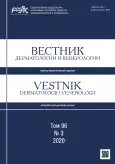Клинический случай синдрома Блоха — Сульцбергера
- Авторы: Краснова Н.В.1, Чернова Т.А.2, Алексеева И.В.1, Гималиева Г.Г.1, Мисякова Т.Ю.1, Синицына Л.Г.1
-
Учреждения:
- Бюджетное учреждение Чувашской Республики «Республиканский кожно-венерологический диспансер» Министерства здравоохранения Чувашской Республики
- ГАУ ЧР ДПО «Институт усовершенствования врачей» Министерства здравоохранения Чувашской Республики
- Выпуск: Том 96, № 3 (2020)
- Страницы: 63-67
- Раздел: НАБЛЮДЕНИЕ ИЗ ПРАКТИКИ
- URL: https://bakhtiniada.ru/0042-4609/article/view/117531
- DOI: https://doi.org/10.25208/vdv1117
- ID: 117531
Цитировать
Полный текст
Аннотация
Цель. Представить клинический случай синдрома Блоха — Сульцбергера.
Материал и методы. Для диагностики заболевания были проведены осмотр кожи, цитологический анализ пузырной жидкости, общий и биохимический анализы крови, генетическое исследование.
Результаты. При осмотре кожи был проведен дифференциальный диагноз с дерматитами, буллезным эпидермолизом и линеарным IgA-зависимым дерматозом у детей. Решающее значение в постановке диагноза принадлежало генетическому исследованию, после проведения которого была выявлена делеция экзонов 4—10 гена IKBKG, что подтвердило синдром Блоха — Сульцбергера.
Заключение. Новорожденные с везикуло-буллезными высыпаниями, поступающие в отделение патологии новорожденных и наблюдаемые неонатологами, требуют тщательного обследования, обязательной консультации дерматолога с целью определения дальнейшей тактики ведения.
Ключевые слова
Полный текст
Открыть статью на сайте журналаОб авторах
Надежда Васильевна Краснова
Бюджетное учреждение Чувашской Республики «Республиканский кожно-венерологический диспансер» Министерства здравоохранения Чувашской Республики
Email: Laricasiniczyna@yandex.ru
главный врач Бюджетного учреждения «Республиканский кожно-венерологический диспансер» Министерства здравоохранения Чувашской Республики
Россия, г.Чебоксары, ул. Пирогова, д. 6Татьяна Алексеевна Чернова
ГАУ ЧР ДПО «Институт усовершенствования врачей» Министерства здравоохранения Чувашской Республики
Email: Laricasiniczyna@yandex.ru
к.м.н., заслуженный врач Российской Федерации, заведующая курсом дерматовенерологии ГАУ ЧР ДПО «Институт усовершенствования врачей» Министерства здравоохранения Чувашской Республики
Россия, г. Чебоксары, ул. Михаила Сеспеля, д. 27Ирина Валерьевна Алексеева
Бюджетное учреждение Чувашской Республики «Республиканский кожно-венерологический диспансер» Министерства здравоохранения Чувашской Республики
Email: Laricasiniczyna@yandex.ru
заместитель главного врача по КЭР Бюджетного учреждения «Республиканский кожно-венерологический диспансер» Министерства здравоохранения Чувашской Республики
Россия, г.Чебоксары, ул. Пирогова, д. 6Гелия Гарефетдиновна Гималиева
Бюджетное учреждение Чувашской Республики «Республиканский кожно-венерологический диспансер» Министерства здравоохранения Чувашской Республики
Email: Laricasiniczyna@yandex.ru
заведующая консультативно-диагностическим отделением Бюджетного учреждения «Республиканский кожно-венерологический диспансер» Министерства здравоохранения Чувашской Республики
Россия, г.Чебоксары, ул. Пирогова, д. 6Татьяна Юрьевна Мисякова
Бюджетное учреждение Чувашской Республики «Республиканский кожно-венерологический диспансер» Министерства здравоохранения Чувашской Республики
Email: Laricasiniczyna@yandex.ru
врач консультативно-диагностического отделения Бюджетного учреждения «Республиканский кожно-венерологический диспансер» Министерства здравоохранения Чувашской Республики
Россия, г.Чебоксары, ул. Пирогова, д. 6Лариса Геннадьевна Синицына
Бюджетное учреждение Чувашской Республики «Республиканский кожно-венерологический диспансер» Министерства здравоохранения Чувашской Республики
Автор, ответственный за переписку.
Email: Laricasiniczyna@yandex.ru
врач консультативно-диагностического отделения Бюджетного учреждения «Республиканский кожно-венерологический диспансер» Министерства здравоохранения Чувашской Республики, ответственный за переписку автор
Россия, г.Чебоксары, ул. Пирогова, д. 6Список литературы
- Aradhya S. A recurrent deletion in the ubiquitously expressed NEMO (IKK-) gene accounts for the vast majority of incontinentia pigmenti mutations. Hum Mol Genet. 2001; 10: 2171—2179.
- Bachevalier F. Atteinte neurologique létale au cours d’une incontinentia pigmenti. Ann Dermatol Venereol. 2003; 130: 1139—1142.
- Berlin A.L. Incontinentia pigmenti: a review and update on the molecular basis of pathophysiology. J Am Acad Dermatol. 2002; 47: 169—187.
- Brown K.D. The roles of the classical and alternative nuclear factor-kappa B pathways: potential implications for autoimmunity and rheumatoid arthritis. Arthritis Res Ther. 2008; 10: 212.
- Chelly J. Genetics and pathophysiology of mental retardation. Eur J Hum Genet. 2006; 14: 701—713.
- Cheng L.E. Persistent systemic inflammation and atypical enterocolitis in patients with NEMO syndrome. Clin Immunol. 2009; 132: 124—131.
- Chiurazzi P. XLMR genes: update 2007. J Eur J Hum Genet. 2008; 16: 422—434.
- Fiorillo L. Bilateral cerebrovascular accidents in incontinentia pigmenti. Pediatr Neurol. 2003; 29: 66—68.
- Fusco F. Molecular analysis of the genetic defect in a large cohort of IP patients and identification of novel NEMO mutations interfering with NF-B activation. Hum Mol Genet. 2004; 13: 1763—1773.
- Fusco F. Alterations of the IKBKG locus and diseases: an update and a report of 13 novel mutations. Hum Mutat. 2008; 29: 595—604.
- Fusco F. Genomic architecture at the Incontinentia Pigmenti locus favours de novo pathological alleles through different mechanisms. Hum Mol Genet. 2012; 21: 1260—1271.
Дополнительные файлы










